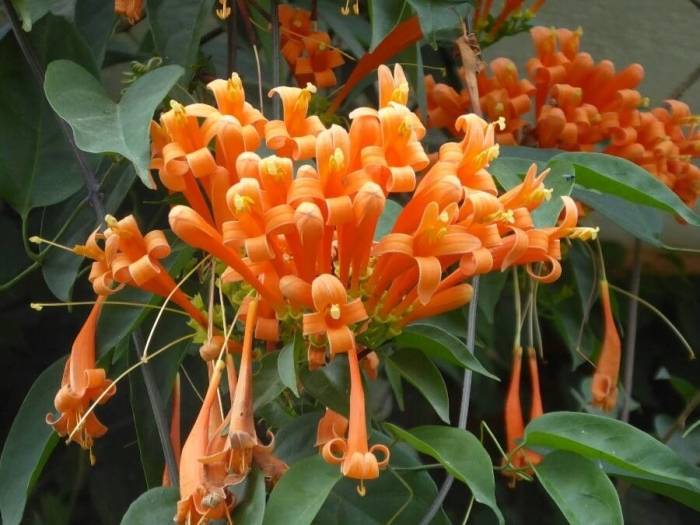Flamevine
(Pyrostegia venusta)
Flamevine (Pyrostegia venusta)
/
/

virginie Lenoir
CC BY-SA 4.0
Image By:
virginie Lenoir
Recorded By:
Copyright:
CC BY-SA 4.0
Copyright Notice:
Photo by: virginie Lenoir | License Type: CC BY-SA 4.0 | License URL: https://creativecommons.org/licenses/by-sa/4.0/ | Attribution: virginie Lenoir (cc-by-sa) | Rights Holder: virginie Lenoir | Publisher: PlantNet | Date Created: 2019-07-15T16:07:20Z | Title: Pyrostegia venusta (Ker Gawl.) Miers: flower | Notes: Pyrostegia venusta (Ker Gawl.) Miers: flower |







































Estimated Native Range
Summary
Pyrostegia venusta, commonly known as Flamevine, is an evergreen perennial vine native to the open woodlands, forest edges, and scrub areas of South America, particularly Brazil, Argentina, and Paraguay. It is a vigorous climber, capable of reaching heights of up to 5 meters (16 feet) when supported. Flamevine is renowned for its stunning display of bright orange tubular flowers, which bloom prolifically from winter to spring and are densely clustered, creating a fiery cascade. Each flower measures approximately 5 to 9 cm in length and is highly attractive to hummingbirds, which are the primary pollinators.
Flamevine is celebrated for its vibrant floral display and is often used to cover fences, trellises, and walls, providing a tropical look to gardens. It thrives in sunny, sheltered locations and requires protection from cold winds. While it prefers well-drained soils, it is notably resistant to soil salinity, making it suitable for coastal areas. In cultivation, it requires minimal maintenance once established, but gardeners should ensure it has a structure to climb on. Its forked tendrils cling readily to rough surfaces, allowing it to spread across large areas. Flamevine’s frost hardiness falls within USDA zones 9 to 11. However, it is potentially invasive outside its native range, and gardeners should consult local regulations before planting.CC BY-SA 4.0
Flamevine is celebrated for its vibrant floral display and is often used to cover fences, trellises, and walls, providing a tropical look to gardens. It thrives in sunny, sheltered locations and requires protection from cold winds. While it prefers well-drained soils, it is notably resistant to soil salinity, making it suitable for coastal areas. In cultivation, it requires minimal maintenance once established, but gardeners should ensure it has a structure to climb on. Its forked tendrils cling readily to rough surfaces, allowing it to spread across large areas. Flamevine’s frost hardiness falls within USDA zones 9 to 11. However, it is potentially invasive outside its native range, and gardeners should consult local regulations before planting.CC BY-SA 4.0
Plant Description
- Plant Type: Vine
- Height: 4-15 feet
- Width: 2-3 feet
- Growth Rate: Rapid
- Flower Color: Orange
- Flowering Season: Spring, Winter
- Leaf Retention: Evergreen
Growth Requirements
- Sun: Full Sun, Part Shade
- Water: Medium
- Drainage: Medium
Common Uses
Bird Garden, Drought Tolerant, Hummingbird Garden, Low Maintenance, Showy Flowers
Natural Habitat
Native to the open woodlands, forest edges, and scrub areas of South America
Other Names
Common Names: Golden Shower , Orange Trumpetvine , Orange-Creeper , Feuer Auf Dem Dach , Feuerranke , Oranje Stephanoot , Flamranka , Flame Vine , Flor De Venus , Lluvia De Fuego
Scientific Names: Pyrostegia venusta , Bignonia venusta , Pyrostegia dichotoma , Pyrostegia venusta var. villosa , Pyrostegia ignea , Bignonia tecomiflora , Pyrostegia pallida , Pyrostegia tecomiflora , Bignonia ignea , Pyrostegia tubulosa
GBIF Accepted Name: Pyrostegia venusta (Ker Gawl.) Miers